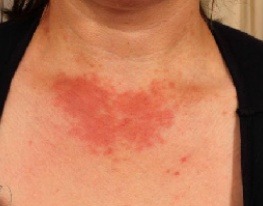About Us

Polymorphic light eruption (PMLE)
It is a rash that appears on uncovered areas (like the face, forearms, V-area of neck and nape of neck) after exposure to sunlight. It is an acquired condition, that is to say no one is born with a light eruption, but it tends to develop over a period of several years. ‘Poly’ means many and ‘Morphic’ means forms, and hence the term polymorphic eruption, as they may present as bumps, rashes or blisters.
PMLE generally occurs in adult females aged 20-40, although it can sometimes affect men and children as well. The rash is itchy, and can often feel like a burn. As it appears on exposed areas, it can be embarrassing. When the rash settles, it can leave an area of altered pigmentation. The rash may be mild or severe and widespread. In severe cases, it can restrict one’s outdoor activities, hobbies and dressing style.
It is believed to be an allergic reaction of sunlight with a protein in the skin. As little as 20 minutes of sunlight can trigger it. It can occur when light is reflected off snow or when light passes through window glass. PMLE can affect as much as 10% of the population and tends to occur in springs. Often it comes up on a holiday or outdoor activities. During springs, the rash tends to affect areas that have been covered with clothing during winter, and are then exposed, eg, the forearms. PMLE is not infectious and is not related to skin cancer or lupus. It is probably not hereditary, although 15% of all patients know of some family member who has it too. The typical appearance and history of sunlight aggravation cinch the diagnosis, although a biopsy, ANA test and a fungal scraping may be helpful in ruling out other sunlight/sweat induced diseases. No treatment will get rid of PMLE forever. However, many people remain clear if they avoid exposure to the sun and use an effective sunscreen. The tendency to get PMLE may go away by itself after a few years.
Mild PMLE can be controlled by avoiding sunlight between 10am to 3pm, wearing protective clothing like hats and full-sleeved clothes, and by using a high SPF wide-spectrum sunscreen.
A small fraction of PMLE patients go on to develop a severe condition called actinic reticuloid. This condition may not respond to the above- mentioned measures. In such cases, PUVA phototherapy is used. This is a way of raising your skin’s resistance by treating it with increasing doses of ultraviolet light in a special phototherapy cubicle. The treatment is given in the early spring so that your skin is ready to cope with the summer sun. After the course of desensitization treatment is over, you should keep up your newly acquired resistance to ultraviolet light by exposing your skin carefully to increasing amounts of sunlight – but not to the point at which the rash comes out again. You will learn how to do this by trial and error. The effect of desensitization treatment wears off in the winter, so it has to be repeated every spring.
DIY Tips
- Learn how much sunlight your skin can tolerate, and keep within that limit.
- Be sure to introduce your skin gradually to sunlight in the spring.

